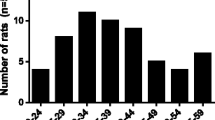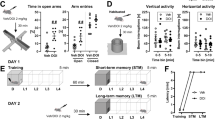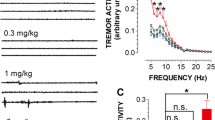Abstract
Rationale
There is some uncertainty whether the acute hyperthermia caused by MDMA (ecstasy) plays a significant role in determining the long-term neurotoxic effects on brain 5-HT systems and associated changes in mood and behaviour.
Objective
The present study assessed whether long-term behavioural and cognitive changes seen in MDMA-treated rats are affected by hyperthermia at the time of drug administration.
Method
Male Wistar rats were treated with MDMA (4×5 mg/kg i.p. over 4 h on 2 consecutive days) or vehicle at either a high ambient temperature (28°C) or a low ambient temperature (16°C). Eight to 18 weeks later, rats were tested in behavioural measures of anxiety (social interaction and emergence tests), a test of cognition (object recognition test) and the forced swim test of depression. At the conclusion of behavioural testing the rats were killed and their brains analysed using HPLC.
Results
MDMA treatment caused a clear and consistent hyperthermia at 28°C and hypothermia at 16°C. Months later, rats pre-treated with MDMA at either 16 or 28°C displayed increased anxiety in the social interaction and emergence tests and reduced escape attempts and increased immobility in the forced swim test. MDMA pre-treatment was also associated with poorer memory on the object recognition test, but only in rats given the drug at 28°C. Rats pre-treated with MDMA showed loss of 5-HT in the hippocampus, striatum, amygdala and cortex, regardless of body temperature at the time of dosing. However, 5-HIAA loss in the amygdala and hippocampus was greater in rats pre-treated at 28°C. Dopamine in the striatum was also depleted in rats given MDMA.
Conclusions
These results indicate that hyperthermia at the time of dosing with MDMA is not necessary to produce subsequent 5-HT depletion and anxiety in rats. They also extend previous findings of long-term effects of brief exposure to MDMA in rats to include apparent "depressive" symptoms in the forced swim model.



Similar content being viewed by others
References
Battaglia G, Yeh SY, O'Hearn E, Molliver ME, Kuhar MJ, De Souza EB (1987) 3,4-Methylenedioxymethamphetamine and 3,4-methylenedioxyamphetamine destroy serotonin terminals in rat brain: quantification of neurodegeneration by measurement of [3H]paroxetine-labeled serotonin uptake sites. J Pharmacol Exp Ther 242:911–916
Blokland A, Lieben C, Deutz NEP (2002) Anxiogenic and depressive-like effects, but no cognitive deficits, after repeated moderate tryptophan depletion in the rat. J Psychopharmacol 16:39–49
Boot BP, McGregor LS, Hall W (2000) MDMA (Ecstasy) neurotoxicity: assessing and communicating the risks. Lancet 355:1818–1821
Bowyer JF, Tank AW, Newport GD, Slikker W Jr, Ali SF, Holson RR (1992) The influence of environmental temperature on the transient effects of methamphetamine on dopamine levels and dopamine release in rat striatum. J Pharmacol Exp Ther 260:817–824
Bowyer JF, Davies DL, Schmued L, Broening HW, Newport GD, Slikker W Jr, Holson RR (1994) Further studies of the role of hyperthermia in methamphetamine neurotoxicity. J Pharmacol Exp Ther 268:1571–1580
Bowyer JF, Holson RR, Miller DB, O'Callaghan JP (2001) Phenobarbital and dizocilpine can block methamphetamine-induced neurotoxicity in mice by mechanisms that are independent of thermoregulation. Brain Res 919:179–183
Broening HW, Bowyer JF, Slikker W (1995) Age-dependent sensitivity of rats to the long-term effects of the serotonergic neurotoxicant (±)-3,4-methylenedioxymethamphetamine (MDMA) correlates with the magnitude of the MDMA-induced thermal response. J Pharmacol Exp Ther 275:325–333
Callahan BT, Cord BJ, Ricaurte GA (2001) Long-term impairment of anterograde axonal transport along fiber projection originating in the rostral raphe nuclei after treatment with fenfluramine or methylenedioxymethamphetamine. Synapse 40:113–121
Chadwick IS, Curry PD, Linsley A, Freemont AJ, Doran B (1991) Ecstasy, 3-4 methylenedioxymethamphetamine (MDMA), a fatality associated with coagulopathy and hyperthermia. J R Soc Med 84:371
Colado MI, Murray TK, Green AR (1993) 5-HT loss in rat brain following 3,4-methylenedioxymethamphetamine (MDMA), p-chloroamphetamine and fenfluramine administration and effects of chlormethiazole and dizocilpine. Br J Pharmacol 108:583–589
Colado MI, Williams JL, Green AR (1995) The hyperthermic and neurotoxic effects of "Ecstasy" (MDMA) and 3,4-methylenedioxyamphetamine (MDA) in the Dark Agouti (DA) rat, a model of the CYP2D6 poor metabolizer phenotype. Br J Pharmacol 115:1281–1289
Colado MI, Granados R, Oshea E, Esteban B, Green AR (1998) Role of hyperthermia in the protective action of clomethiazole against MDMA (Ecstasy)-induced neurodegeneration, comparison with the novel nmda channel blocker AR-R15896AR. Br J Pharmacol 124:479–484
Colado MI, O'Shea E, Esteban B, Granados R, Green AR (1999) In vivo evidence against clomethiazole being neuroprotective against MDMA ("Ecstasy")-induced degeneration of rat brain 5-HT nerve terminals by a free radical scavenging mechanism. Neuropharmacology 38:307–314
Colado MI, O'Shea E, Esteban B, Green AR (2001) Studies on the neuroprotective effect of the enantiomers of AR-A008055, a compound structurally related to clomethiazole, on MDMA ("Ecstasy")-induced neurodegeneration in rat brain. Psychopharmacology 157:82–88
Cryan JF, Markou A, Lucki I (2002) Assessing antidepressant activity in rodents: recent developments and future needs. Trends Pharmacol Sci 23:238–245
Dafters RI (1994) Effect of ambient temperature on hyperthermia and hyperkinesis induced by 3,4-methylenedioxymethamphetamine (MDMA or Ecstasy) in rats. Psychopharmacology 114:505–508
Dafters RI (1995) Hyperthermia following MDMA administration in rats—effects of ambient temperature, water consumption, and chronic dosing. Physiol Behav 58:877–882
Farfel GM, Seiden LS (1995) Role of hypothermia in the mechanism of protection against serotonergic toxicity.1. Experiments using 3,4-methylenedioxymethamphetamine, dizocilpine, CGS 9755 and NBQX. J Pharmacol Exp Ther 272:860–867
Fischer C, Hatzidimitriou G, Wlos J, Katz J, Ricaurte G (1995) Reorganization of ascending 5-HT axon projections in animals previously exposed to the recreational drug (±)3,4-methylenedioxymethamphetamine (MDMA, "Ecstasy"). J Neurosci 15:5476–5485
Gordon CJ, Watkinson WP, O'Callaghan JP, Miller DB (1991) Effects of 3,4-methylenedioxymethamphetamine on autonomic thermoregulatory responses of the rat. Pharmacol Biochem Behav 38:339–344
Green AR, McGregor IS (2002) On the long-term increase in anxiety following central serotonin depletion with MDMA ("Ecstasy"). Psychopharmacology 162:448–450
Green AR, Cross AJ, Goodwin GM (1995) Review of the pharmacology and clinical pharmacology of 3,4-methylenedioxymethamphetamine (MDMA or Ecstasy). Psychopharmacology 119:247–260
Gurtman CG, Morley KC, Li KM, Hunt GE, McGregor IS (2002) Increased anxiety in rats after 3,4-methylenedioxymethamphetamine: association with serotonin depletion. Eur J Pharmacol 446:89–96
Harkin A, Connor TJ, Mulrooney J, Kelly JP, Leonard BE (2001) Prior exposure to methylenedioxyamphetamine (MDA) induces serotonergic loss and changes in spontaneous exploratory and amphetamine-induced behaviors in rats. Life Sci 68:1367–1382
Henry JA, Jeffreys KJ, Dawling S (1992) Toxicity and deaths from 3,4-methylenedioxymethamphetamine ("Ecstasy"). Lancet 340:384–387
Liechti ME, Saur MR, Gamma A, Hell D, Vollenweider FX (2000) Psychological and physiological effects of MDMA ("Ecstasy") after pretreatment with the 5-HT2 antagonist ketanserin in healthy humans. Neuropsychopharmacology 23:396–404
Malberg JE, Seiden LS (1997) Administration of fenfluramine at different ambient temperatures produces different core temperature and 5-HT neurotoxicity profiles. Brain Res 765:101–107
Malberg JE, Seiden LS (1998) Small changes in ambient temperature cause large changes in 3,4-methylenedioxymethamphetamine (MDMA)-induced serotonin neurotoxicity and core body temperature in the rat. J Neurosci 18:5086–5094
Malberg JE, Sabol KE, Seiden LS (1996) Co-administration of MDMA with drugs that protect against MDMA neurotoxicity produces different effects on body temperature in the rat. J Pharmacol Exp Ther 278:258–267
Mallick A, Bodenham AR (1997) MDMA induced hyperthermia: a survivor with an initial body temperature of 42.9 degrees C. J Accident Emer Med 14:336–338
Marston HM, Reid ME, Lawrence JA, Olverman HJ, Butcher SP (1999) Behavioural analysis of the acute and chronic effects of MDMA treatment in the rat. Psychopharmacology 144:67–76
Matuszewich L, Filon ME, Finn DA, Yamamoto BK (2002) Altered forebrain neurotransmitter responses to immobilization stress following 3,4-methylenedioxymethamphetamine. Neuroscience 110:41–48
Mechan AO, Moran PM, Elliott JM, Young AMJ, Joseph MH, Green AR (2002) A study of the effects of a single neurotoxic dose of 3,4-methylenedioxymethamphetamine (MDMA; Ecstasy) on the subsequent long-term behaviour of rats in the plus maze and open field. Psychopharmacology 159:167–175
Morgan MJ (2000) Ecstasy (MDMA): a review of its possible persistent psychological effects. Psychopharmacology 152:230–248
Morley KC, Gallate JE, Hunt GE, Mallet PE, McGregor IS (2001) Increased anxiety and impaired memory in rats 3 months after administration of 3,4-methylenedioxymethamphetamine ("Ecstasy"). Eur J Pharmacol 433:91–99
O'Loinsigh ED, Boland G, Kelly JP, O'Boyle KM (2001) Behavioural, hyperthermic and neurotoxic effects of 3,4-methylenedioxymethamphetamine analogues in the Wistar rat. Prog Neuro-Psychopharmacol Biol Psychiatry 25:621–638
O'Shea E, Granados R, Esteban B, Colado MI, Green AR (1998) The relationship between the degree of neurodegeneration of rat brain 5-HT nerve terminals and the dose and frequency of administration of MDMA (Ecstasy). Neuropharmacology 37:919–926
Parrott AC (2001) Human psychopharmacology of Ecstasy (MDMA): a review of 15 years of empirical research. Hum Psychopharmacol 16:557–577
Parrott AC (2002) Recreational Ecstasy/MDMA, the serotonin syndrome, and serotonergic neurotoxicity. Pharmacol Biochem Behav 71:837–844
Parrott AC, Lasky J (1998) Ecstasy (MDMA) effects upon mood and cognition—before, during and after a Saturday night dance. Psychopharmacology 139:261–268
Prickaerts J, van Staveren WCG, Sik A, Markerink-van Ittersum M, Niewohner U, van der Staay FJ, Blokland A, de Vente J (2002) Effects of two selective phosphodiesterase type 5 inhibitors, sildenafil and vardenafil, on object recognition memory and hippocampal cyclic GMP levels in the rat. Neuroscience 113:351–361
Ricaurte G, Bryan G, Strauss L, Seiden L, Schuster C (1985) Hallucinogenic amphetamine selectively destroys brain serotonin nerve terminals. Science 229:986–988
Ricaurte GA, McCann UD, Szabo Z, Scheffel U (2000) Toxicodynamics and long-term toxicity of the recreational drug, 3,4-methylenedioxymethamphetamine (MDMA, "Ecstasy"). Toxicol Lett 112:143–146
Ricaurte G, Yuan J, Hatzidimitriou G, Cord BJ, McCann UD (2002) Severe dopaminergic neurotoxicity in primates after a common recreational dose regimen of MDMA ("Ecstasy"). Science 297: 2260–2263
Scanzello CR, Hatzidimitriou G, Martello AL, Katz JL, Ricaurte GA (1993) Serotonergic recovery after (±)3,4-(methylenedioxy) methamphetamine injury: observations in rats. J Pharmacol Exp Ther 264:1484–1491
Schifano F (2000) Potential human neurotoxicity of MDMA ("Ecstasy"): Subjective self-reports, evidence from an Italian drug addiction centre and clinical case studies. Neuropsychobiology 42:25–33
Schifano F, Difuria L, Forza C, Minicuci N, Bricolo R (1998) MDMA (Ecstasy) consumption in the context of polydrug abuse—a report on 150 patients. Drug Alcohol Depend 52:85–90
Schmidt CJ, Black CK, Abbate GM, Taylor VL (1990) Methylenedioxymethamphetamine-induced hyperthermia and neurotoxicity are independently mediated by 5-HT2 receptors. Brain Res 529:85–90
Schworer H, Racke K, Kilbinger H (1987) Cholinergic modulation of the release of 5-hydroxytryptamine from the guinea pig ileum. Naunyn-Schmiedeberg's Arch Pharmacol 336:127–132
Topp L, Hando J, Dillon P, Roche A, Solowij N (1999) Ecstasy use in Australia: patterns of use and associated harm. Drug Alcohol Depend 55:105–115
Acknowledgements
This work was supported by an NH&MRC grant to Iain S. McGregor and Glenn E. Hunt. We are grateful to Geoffrey van der Plasse for technical assistance and to Darek Figa and Debbie Brookes for animal care.
Author information
Authors and Affiliations
Corresponding author
Rights and permissions
About this article
Cite this article
McGregor, I.S., Gurtman, C.G., Morley, K.C. et al. Increased anxiety and "depressive" symptoms months after MDMA ("ecstasy") in rats: drug-induced hyperthermia does not predict long-term outcomes. Psychopharmacology 168, 465–474 (2003). https://doi.org/10.1007/s00213-003-1452-8
Received:
Accepted:
Published:
Issue Date:
DOI: https://doi.org/10.1007/s00213-003-1452-8




